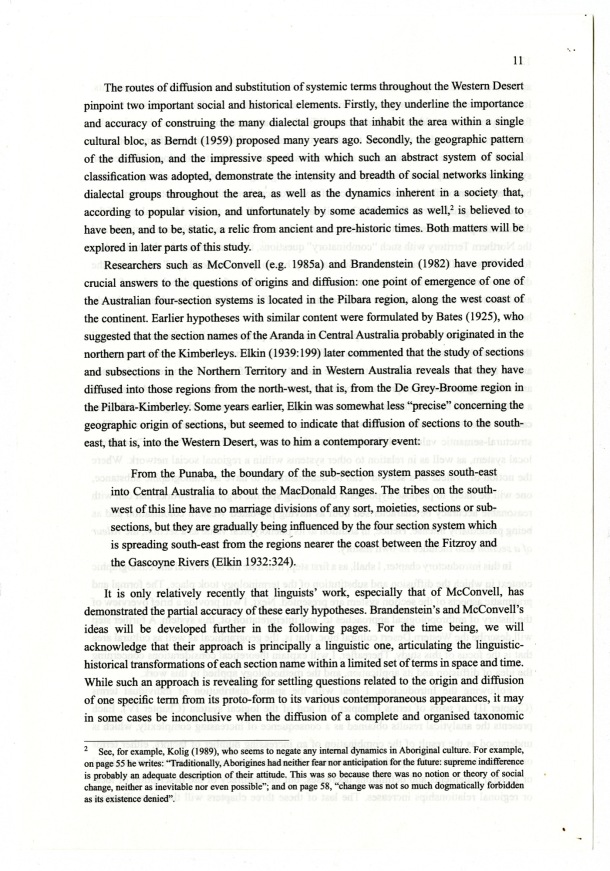|
| 
[Note: this transcription was produced by an automatic OCR engine]
11
The routes of difliision and substitution of systemic terms throughout the Western Desert
pinpoint two important social and historical elements. Firstly, they underline the importance
and accuracy of construing the many dialectal groups that inhabit the area within a single
cultural bloc, as Bemdt 1959 proposed many years ago. Secondly, the geographic pattern
of the dilfusion, and the impressive speed with which such an abstract system of social
classification was adopted, demonstrate the intensity and breadth of social networks linking
dialectal groups throughout the area, as well as the dynamics inherent in a society that,
according to popular vision, and unfortunately by some academics as well,‘ is believed to
have been, and to be, static, a relic from ancient and pre-historic times. Both matters will be
explored in later parts of this study.
Researchers such as McConvell e.g. 1985a and Brandenstein 1982 have provided
crucial answers to the questions of origins and difliision: one point of emergence of one of
the Australian four—section systems is located in the Piibara region, along the west coast of
the continent. Earlier hypotheses with similar content were formulated by Bates 1925, who
suggested that the section names of the Aranda in Central Australia probably originated in the
northern part of the Kimberleys. Elkin 1939: 199 later commented that the study of sections
and subsections in the Northern Territory and in Western Australia reveals that they have
diffused into those regions from the north-west, that is, from the De Grey-Broome region in
the Pilbara-Kimberley. Some years earlier, Elldn was somewhat less “precise” concerning the
geographic origin of sections, but seemed to indicate that diffusion of sections to the south-
east, that is, into the Western Desert, was to h.im a contemporary event:
From the Punaba, the boundary of the sub-section system passes south-east
into Central Australia to about the MacDonald Ranges. The tribes on the south-
west of this line have no marriage divisions of any sort, moieties, sections or sub-
sections, but they are gradually being influenced by the four section system which
is spreading south-east from the regions nearer the coast between the Fitzroy and
the Gascoyne Rivers Elkin 19322324.
It is only relatively recently that linguists’ work, especially that of McConvell, has
demonstrated the partial accuracy of these early hypotheses. Brandenstein’s and McConvell’s
ideas will be developed further in the following pages. For the time being, we will
acknowledge that their approach is principally a linguistic one, articulating the linguistic-
historical transformations of each section name within a limited set of terms in space and time.
While such an approach is revealing for settling questions related to the origin and diffusion
of one specific term from its proto—form to its various contemporaneous appearances, it may
in some cases be inconclusive when the ditfusion of a complete and organised taxonomic
2 See, for example, Kolig 1989, who seems to negate any internal dynamics in Aboriginal culture. For example,
on page 55 he writes: ‘Tradifionally. Aborigines had neither fear nor anficipation for the future: supreme indifference
is probably an adequate description of their attitude. This was so because there was no nation or theory of social
change, neither as inevitable nor even possible"; and on page 58, “change was not so much dogmatically forbidden
as its existence denied”.
|